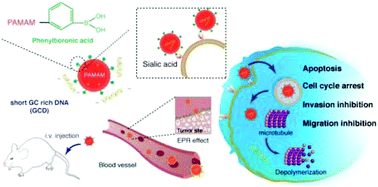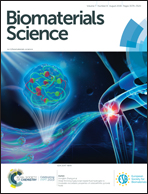Phenylboronic acid-modified polyamidoamine-mediated delivery of short GC rich DNA for hepatocarcinoma gene therapy†
Abstract
Phenylboronic acid was introduced on the surface of polyamidoamine to construct a derivative PP, which was further used as a tumor-targeting carrier for realizing the delivery of short GC rich DNA (GCD). The PP-mediated GCD delivery could disrupt the polymerization of microtubules and thus trigger a strong anti-proliferative effect through the induction of cell apoptosis and cell cycle arrest, using hepatocellular carcinoma cell line HepG2 as a model. In addition, the transfection of PP/GCD nanoparticles could efficiently suppress cell migration and invasion. Moreover, the intravenous injection of PP/GCD nanoparticles could dramatically decrease the tumor growth by inducing the in situ apoptosis of the tumor and meanwhile it exhibited a desirable safety profile. Overall, the development of tumor-targeting carrier PP will provide a promising platform for GCD delivery to obtain an anti-cancer efficacy which is beneficial for facilitating tumor gene therapy in future clinical applications.



 Please wait while we load your content...
Please wait while we load your content...